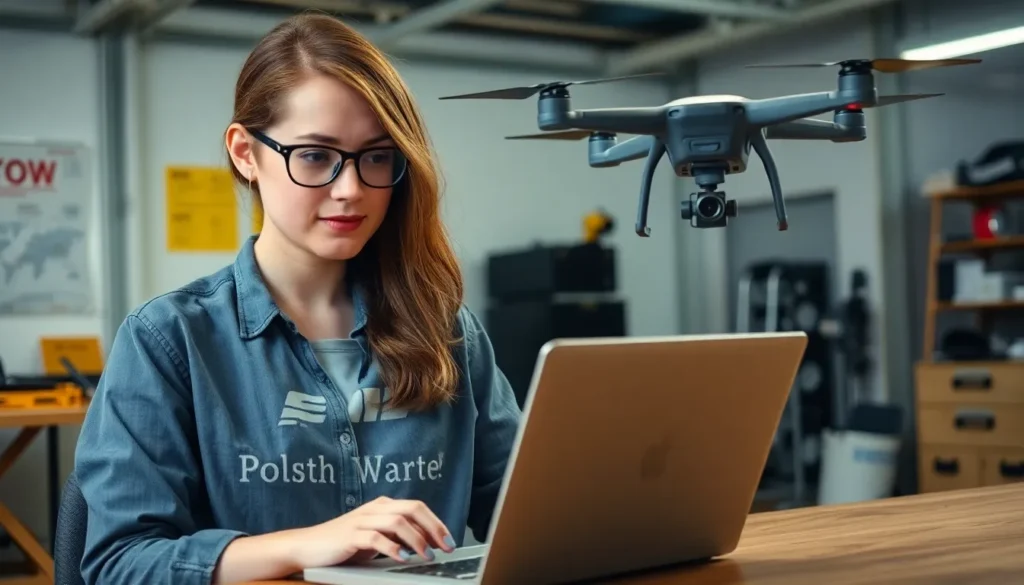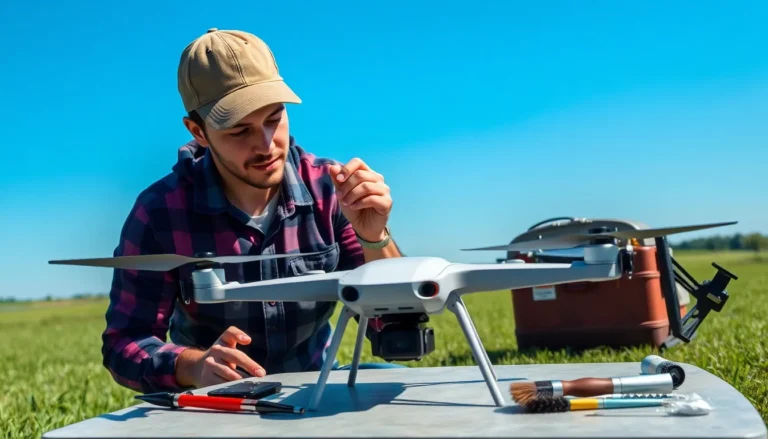In a world where drones have gone from sci-fi dreams to everyday delivery buddies, the magic behind them lies in the art of drone software engineering. It’s not just about making flying robots; it’s about crafting the brains that make them smarter than your average pet. Who wouldn’t want to program a machine that can dodge trees, avoid nosy birds, and deliver pizza without a hitch?
Table of Contents
ToggleOverview of Drone Software Engineering
Drone software engineering focuses on creating the algorithms and frameworks that power drone functionality. Professionals in this field design software to handle various tasks, including navigation, data collection, and autonomous flight. Key components of drone software include control systems, communication protocols, and sensor integration.
Control systems enable drones to maintain stability and respond to changing environments. They incorporate feedback loops to adjust positions based on sensor inputs. Communication protocols allow drones to communicate with ground control stations, ensuring seamless data transfer and operational control.
Sensor integration is crucial for drones to perceive their surroundings accurately. Cameras, LiDAR, and ultrasonic sensors gather data about obstacles and terrain. This information feeds into the software algorithms, allowing drones to make real-time decisions during flight.
Developers utilize programming languages such as C++, Python, and ROS (Robot Operating System) in drone software engineering. C++ offers performance advantages, while Python provides ease of use for rapid prototyping. ROS serves as a flexible framework, simplifying the process of developing complex robotics applications.
Multiple software development approaches exist in this domain. Agile methodologies enable teams to adapt quickly to emerging technologies and user needs. Continuous testing ensures that the software remains robust and reliable.
Safety protocols play a vital role in drone software engineering. Implementing fail-safes and redundancy measures reduces risks associated with malfunctioning drones. Compliance with regulations ensures that drones operate safely within regulatory frameworks, contributing to public acceptance and trust in drone technology.
Importance of Drone Software Engineering

Drone software engineering plays a crucial role in the operational success and safety of drones. Its significance spans various aspects, from compliance with regulations to optimizing performance.
Safety and Compliance
Adhering to safety regulations guarantees that drones operate within legal frameworks, reducing potential hazards. Establishing fail-safes ensures drones can handle emergencies without compromising nearby individuals or property. Integration of safety protocols fosters trust among users and the public. Meeting industry standards also addresses concerns over privacy and airspace regulations, enhancing acceptance of drone technology in various environments. Compliance with local and national aviation authorities helps maintain a structured approach to drone operations.
Efficiency and Performance
Enhancing drone efficiency depends on well-designed software that optimizes flight paths and resource management. Algorithms aid in real-time decision-making, ensuring drones adapt quickly to changing conditions. Performance metrics allow engineers to refine software, ultimately improving speed, endurance, and payload capabilities. Streamlined communication systems play a vital role in reducing latency and ensuring seamless data transfer between drones and ground control. Overall, robust software systems lead to increased operational effectiveness, making drones valuable tools across multiple industries.
Key Components of Drone Software
Drone software relies on several crucial components that empower their functionality and efficiency in various applications.
Flight Control Systems
Flight control systems play a vital role in stabilizing drones during flight. These systems receive input from sensors and adjust control surfaces or motor speeds to maintain balance. Advanced algorithms process this data in real-time, ensuring smooth operation even in turbulent conditions. These systems also enable automated flight features, allowing drones to execute intricate maneuvers such as hovering or path following. Ultimately, effective flight control systems enhance the safety and reliability of drone operations across diverse environments.
Navigation and Mapping
Navigation and mapping systems provide essential information for drones to move autonomously. They utilize GPS, inertial measurement units, and other sensors to establish precise locations and orientations. High-resolution mapping technologies, such as LiDAR and computer vision, allow drones to generate detailed 3D maps of their surroundings. These systems detect and avoid obstacles, optimizing flight paths for efficiency and safety. By integrating these components, drones can perform complex tasks like surveying terrain or inspecting infrastructure with accuracy.
Development Challenges in Drone Software Engineering
Drone software engineering faces various challenges that impact development and deployment. Developers navigate these complexities to ensure safe and effective autonomous operations.
Regulatory Constraints
Regulatory constraints significantly influence drone software engineering. Compliance with local and international regulations is mandatory for developers. This ensures safety and legality during operations. Governments impose restrictions on flight altitude, no-fly zones, and data privacy. Understanding these regulations is crucial for software design that meets safety standards. Developing software that adheres to regulations fosters public trust. Additionally, keeping up with evolving policies requires constant awareness among engineers and stakeholders.
Technical Limitations
Technical limitations pose significant hurdles in drone software engineering. Hardware capabilities often restrict software functionality. Limited battery life affects flight duration, while processing power impacts real-time data processing. Sensor reliability also varies, influencing autonomous decision-making. Engineers must design software that optimizes performance despite these constraints. Calibration between software and hardware is essential for seamless integration. Continuous advancements in technology, such as improved sensors, pave the way for overcoming these limitations. Successful adaptation to technical challenges enhances the overall effectiveness of drone applications across industries.
Future Trends in Drone Software Engineering
Emerging trends in drone software engineering highlight the growing significance of advanced technologies in enhancing drone capabilities. Innovations like artificial intelligence and enhanced autonomy stand out as pivotal developments.
Artificial Intelligence Integration
Artificial intelligence reshapes the landscape of drone software engineering. It empowers drones to analyze vast amounts of data in real time, leading to smarter decision-making processes. Various algorithms enable drones to learn from experiences, improving navigation and task execution over time. Machine learning enhances sensor data interpretation, allowing drones to identify obstacles and optimize flight paths. As engineers integrate AI technologies, drones become increasingly capable of performing complex tasks autonomously, fostering greater adaptability across multiple industries.
Enhanced Autonomy
Autonomy in drone software engineering experiences significant advancements. More sophisticated algorithms enable drones to operate independently, minimizing human intervention. Autonomous systems streamline flight operations, allowing for efficient task completion in diverse environments. Improved sensor fusion techniques enhance situational awareness, ensuring drones navigate safely even in challenging conditions. Emphasizing real-time data processing boosts overall performance, allowing drones to make informed decisions instantly. As autonomous technology evolves, the potential applications for drones expand, greatly influencing sectors such as agriculture, logistics, and surveillance.
Drone software engineering stands at the forefront of innovation in various industries. Its role in developing intelligent systems is vital for optimizing drone functionality and ensuring safety during operations. As technology advances the integration of AI and enhanced autonomy will likely redefine how drones operate and interact with their environments.
The challenges faced in this field underscore the importance of continuous improvement and adherence to safety regulations. By addressing technical limitations and regulatory constraints engineers can enhance the reliability and efficiency of drone applications. The future holds exciting possibilities for drone technology driven by sophisticated software solutions that promise to transform everyday tasks and industries alike.










